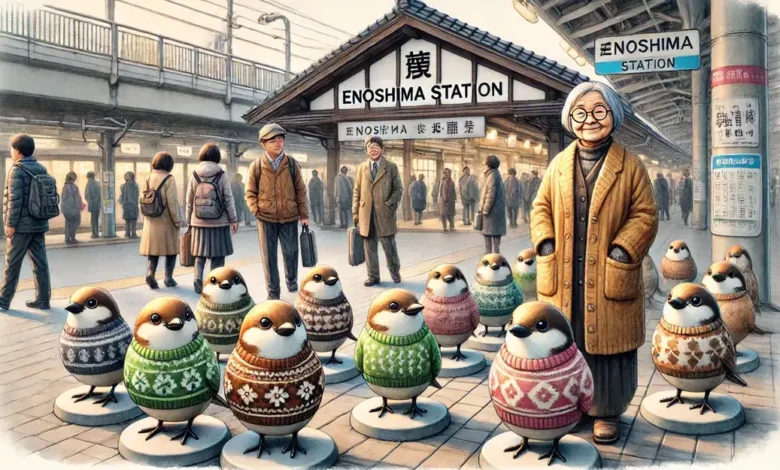Amid the bustling charm of Enoshima Station lies a story that seems almost too whimsical to be true. Mrs. Ishikawa Katsuko, with her incredible creativity and care, began a unique tradition that captured hearts across Japan. Starting in 1999, she lovingly knitted tiny sweaters for the bronze sparrow sculptures perched by the station. These colorful outfits, tailored for holidays or seasons, turned the once-overlooked sparrows into local icons. Her small, thoughtful act transformed Enoshima Station into a symbol of kindness and imagination, reminding visitors of the power of connection. Even after her passing in 2016, her gentle legacy continues, inspiring others to embrace these small yet meaningful gestures.
Enoshima Station: A Gateway to Serenity
Nestled along Japan’s picturesque coastline, Enoshima Station is more than just a transportation hub. It serves as a portal to the enchanting Enoshima Island, welcoming visitors with its unique charm and serene atmosphere. Let’s take a closer look at what makes Enoshima Station so captivating.
A Brief History of Enoshima Station
Enoshima Station, opened in 1902, has witnessed over a century of local history. The station’s name, adopted in 1929, reflects its vital role in connecting visitors to Enoshima Island, a popular destination for tourists and pilgrims alike. The Enoden Line’s vintage vibe enhances the station’s nostalgic atmosphere, making every arrival feel like a step back in time.
The station’s architecture blends tradition with modernity, characterized by a simple yet elegant design that mirrors the tranquility of the surrounding area. The Enoden Line itself is renowned for its scenic route, running alongside beautiful coastal landscapes and charming neighborhoods. The short walk from the station to the island via a picturesque bridge sets the tone for an unforgettable journey.
For more details on Enoshima Station’s history and its architectural charm, see Enoshima Station on Japan Travel.
The Artistic Symbolism at the Station
One of Enoshima Station’s most endearing features is its artistic details, especially the metal sparrows perched near its entrance. These sculptures are simple yet meaningful, symbolizing companionship and joy. The sparrows gained fame thanks to Mrs. Ishikawa Katsuko, who crocheted tiny sweaters for them, creating a touching tradition still cherished today.
The station acts like an open-air gallery, with every detail reflecting the area’s natural beauty and culture. The sparrows are more than mere decorations—they embody warmth, kindness, and the community’s creative spirit. Visitors often pause to admire them, making these little birds a beloved part of every trip to Enoshima.
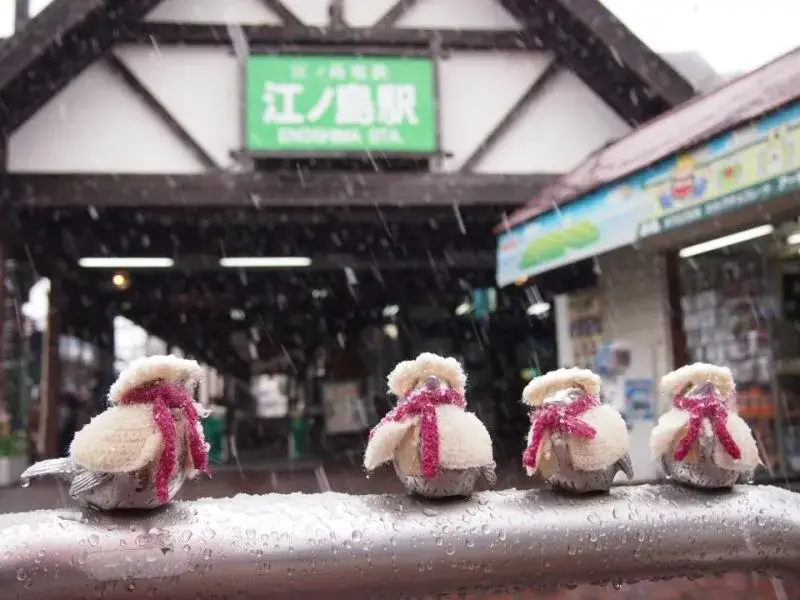
Every visit to Enoshima Station offers a glimpse into the harmonious blend of art, history, and local culture, truly earning its place as a gateway to serenity.
Who is Mrs. Ishikawa Katsuko?
Mrs. Ishikawa Katsuko is a name many associate with love, creativity, and an enduring legacy of community spirit. Her unique story revolves around her lifelong dedication to the small yet meaningful act of crocheting tiny sweaters for bronze sparrow statues at Enoshima Station. This simple yet profound tradition began in 1999 and continues to touch hearts even after her passing.
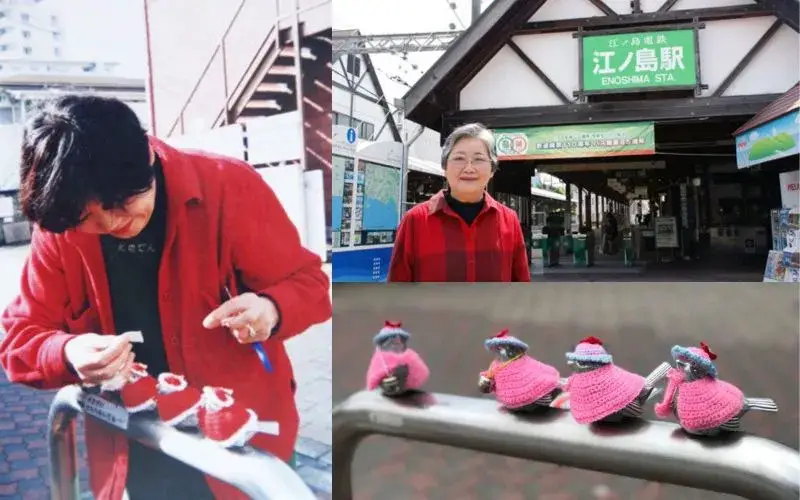
A Woman of Heartwarming Dedication
Every day, Mrs. Katsuko visited Enoshima Station, a journey that became a ritual of kindness. Toward the station’s entrance sat several bronze sparrow sculptures, small and often overlooked. But to Mrs. Katsuko, these were more than decorations—they were companions deserving of warmth. She began crocheting tiny, colorful sweaters to clothe these birds, changing them routinely to match seasons, holidays, or festivals.
Her work captured the imaginations of locals and visitors alike. Something as small as a sweater transformed lifeless sculptures into symbols of care and connection. People passing through would pause to admire her creations, often snapping photos or sharing stories of the cheerful addition to their day. Mrs. Katsuko’s sweaters didn’t just protect metal sparrows—they shielded the community from indifference.
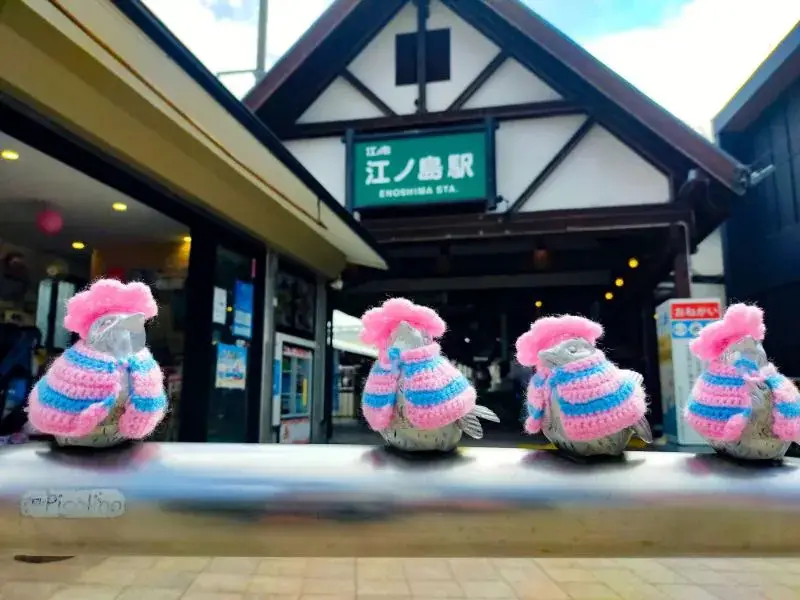
The Inspiration Behind the Sweaters
What inspired her dedication to these bronze figures? According to accounts, Mrs. Katsuko noticed how cold the sparrows looked, especially during harsh winters. This feeling sparked an idea: why not dress them in handmade sweaters? Her efforts reflected an empathetic heart that couldn’t bear even inanimate sparrows appearing “cold” or forgotten. In Japanese culture, sparrows symbolize loyalty and community, making her act even more profound.
Her crocheted garments weren’t just functional; they served as a vibrant homage to the seasons. Festive reds for New Year’s, gentle pastels for spring, or golden autumn hues. Each piece represented her commitment to bringing joy and celebrating life’s fleeting yet beautiful moments.
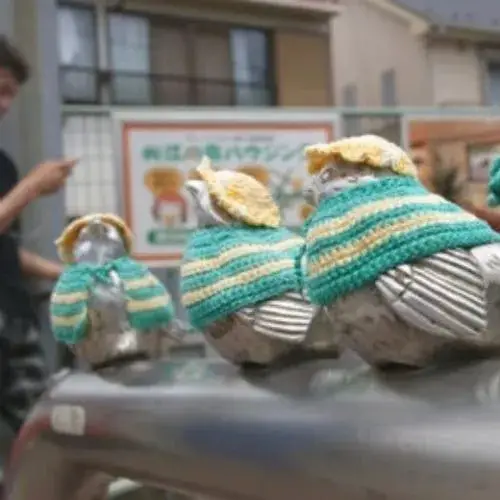
Connecting with the Community
Mrs. Ishikawa’s thoughtful tradition did more than brighten sparrow sculptures—it bridged connections among locals and tourists. Her act of kindness sparked conversations at the station, and many began to see Enoshima Station not just as a transit point but as a beacon of community spirit. Visitors who might never have stopped took the time to admire the bronze birds, discuss Mrs. Katsuko’s work, and share smiles over her artistic contributions.
The ripple effect of her kindness was apparent. Residents started contributing their own small gestures to the station area, inspired by her dedication. Tourists shared her story on social media, drawing even more attention to the station and its unique charm. Her sweaters turned Enoshima Station into more than a gateway—it became a symbol of how one person’s thoughtful actions could inspire an entire community.
Mrs. Katsuko’s story lives on, reminding us that even the smallest gestures can create profound connections.
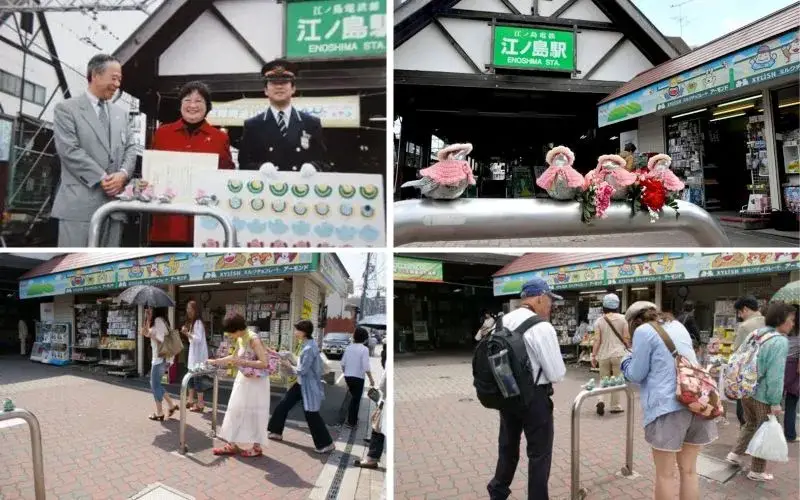
The Sparrows: A Unique Symbolism
At Enoshima Station, the bronze sparrows perched at the entrance have become more than mere sculptures. Thanks to Mrs. Ishikawa Katsuko’s thoughtful gesture of knitting tiny sweaters, they now embody care, creativity, and cultural heritage. Let’s explore the deeper layers of this charming story.
The Cold Winter and Tiny Sweaters
The idea began with a simple observation—bronze sparrows, exposed to the elements, looked particularly cold during the chill of winter. Mrs. Katsuko, with her skillful hands and empathetic heart, crocheted miniature sweaters for these statues. Imagine the delicate stitches, vibrant colors, and snug fits; they were not only adorable but also practical.
Winter mornings at Enoshima Station gained a cheerful liveliness as the sparrows sported festive sweaters in hues of red, green, or wintry white. Seasonal and holiday-inspired designs further elevated the charm. Beyond aesthetics, these sweaters prevented frost from forming on the sculptures, preserving their metal sheen. Daily commuters couldn’t help but smile, reminding them of the warmth of human creativity amid the cold steel surroundings.
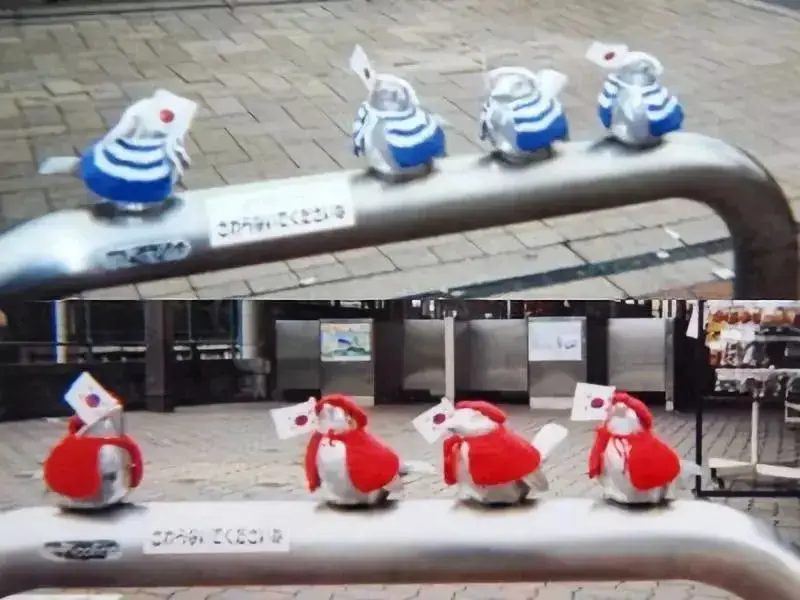
A Testament to Japanese Craftsmanship
Mrs. Katsuko’s sweaters are a beautiful reflection of Japan’s deep love for handmade artistry. In Japanese culture, creating something by hand is seen as a form of respect and care. Her intricate crocheting fit seamlessly into this tradition, highlighting attention to detail and patience.
This aligns with the broader tradition of kogei (artisan crafts), which values both functionality and beauty. From pottery to textiles, Japanese craftsmanship is built on precision and devotion. Mrs. Katsuko’s work carries this torch forward, albeit on a smaller scale. Her tiny creations remind visitors of the handmade goods woven into Japan’s cultural fabric.
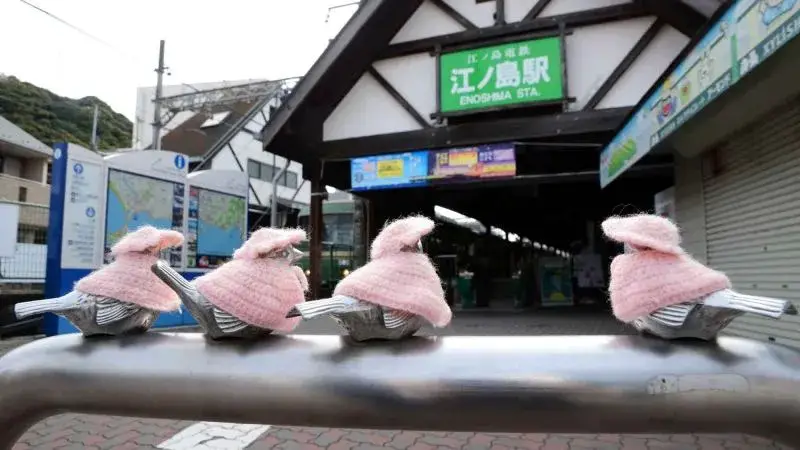
Why the Sparrows Hold a Special Place
In Japan, sparrows symbolize much more than birds flitting about in gardens. These creatures represent community, loyalty, and diligence—a reflection of Mrs. Katsuko herself. Sparrows often nestle close to people, embodying companionship and trust, qualities that resonate deeply in Japanese traditions.
Stories in Japanese folklore often spotlight sparrows as symbols of joy and teamwork. They appear in patterns on kimonos, paintings, and literature, celebrating their unassuming beauty. For Mrs. Katsuko, choosing sparrows wasn’t by chance—it was a thoughtful act to bring life and warmth to station visitors. Their transformation into dressed-up mascots also added a touch of whimsy to Enoshima Station’s allure. Explore more about sparrow symbolism in Japan at Japanese Symbolism of Sparrows.
At Enoshima Station, these sparrows aren’t just statues—they’re characters in a story of resilience and care.
In 2016, after many years of making sweaters for the birds, Mrs. Ishikawa passed away. Many people were very sad. But thanks to her, the little bronze birds at Enoshima Station always have something warm to wear.
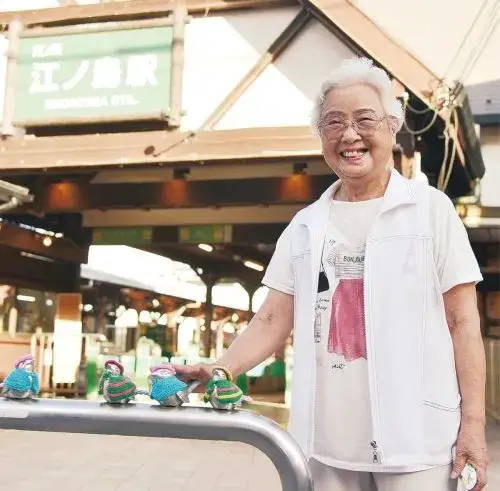
How the Story Touched the World
The heartwarming tale of Mrs. Ishikawa Katsuko and her sparrow sweaters reached beyond Enoshima Station, touching lives worldwide. This simple, kindhearted act became a powerful symbol of the beauty found in small gestures.
Social Media Buzz and Global Appreciation

Photo by Magnus Mueller
Social media played a key role in amplifying Mrs. Katsuko’s unique story. When tourists stopped by Enoshima Station, photographed the sparrows in their tiny sweaters, and shared them online, the narrative spread like wildfire. Soon, travel writers and bloggers began documenting her legacy, making these knitted sparrows a viral sensation.
Platforms like Instagram and Twitter allowed people to engage with her story in real-time. Posts featuring the sweaters often included captions that highlighted themes of creativity, empathy, and the importance of small actions in building community ties. Hashtags, photo challenges, and even blog posts emerged, turning Mrs. Katsuko’s act into an international message of kindness.
This movement exemplified how social media can transcend borders, connecting people through shared admiration for simple yet impactful acts. While technology can sometimes feel isolating, stories like Mrs. Katsuko’s remind us of its power to bring strangers together for a common cause. To learn more about how shared narratives influence social platforms, you can check this article on Japan and social media narratives.
Tourism and Cultural Curiosity
The sparrow sweaters didn’t just charm people online—they turned Enoshima Station into a must-visit destination. Tourists, intrigued by the heartwarming tale, began adding the station to their travel itineraries. They wanted to experience firsthand the artistic sparrows dressed seasonally and learn about the spirit behind this tradition.
Enoshima Station became more than a transit hub; it evolved into a cultural landmark. The story of Mrs. Katsuko intertwined seamlessly with the identity of the station, and visitors came seeking a deeper connection to Japanese values of craftsmanship, community, and subtle beauty. Local businesses around the area also benefited, as increased foot traffic brought newfound attention to Enoshima Island’s rich attractions.
For travelers inspired by unique stories, Enoshima Station became a starting point to explore other cultural treasures nearby, including the spiritual offerings of Enoshima Island. To discover all the amazing spots to visit in the area, see Exploring Enoshima: A Treasure Island Off Tokyo’s Coast.
From social recognition to increased tourism, Mrs. Katsuko’s sparrows remind us that a single act can ripple outward, inspiring a new wave of curiosity, kindness, and appreciation across the globe.
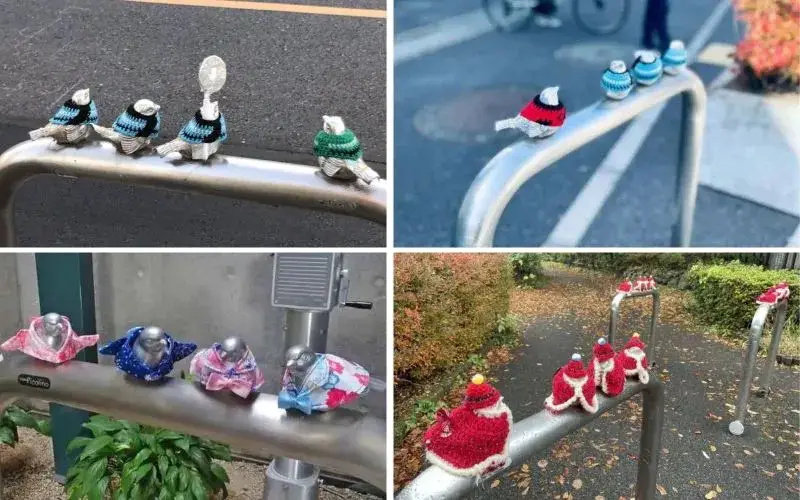
Enoshima Station: More Than a Transit Hub
Enoshima Station is not your average stop on a train journey. It’s a place where a unique story transforms everyday commutes into moments of reflection and joy. This is where Mrs. Ishikawa Katsuko left a legacy that resonates with visitors from around the globe. Her small but meaningful actions remind us that even the tiniest gestures can weave deeper connections. Let’s uncover how her story has touched the hearts of those who pass through this station and how it mirrors the essence of Japanese cultural values.
Unforgettable Visitor Experiences
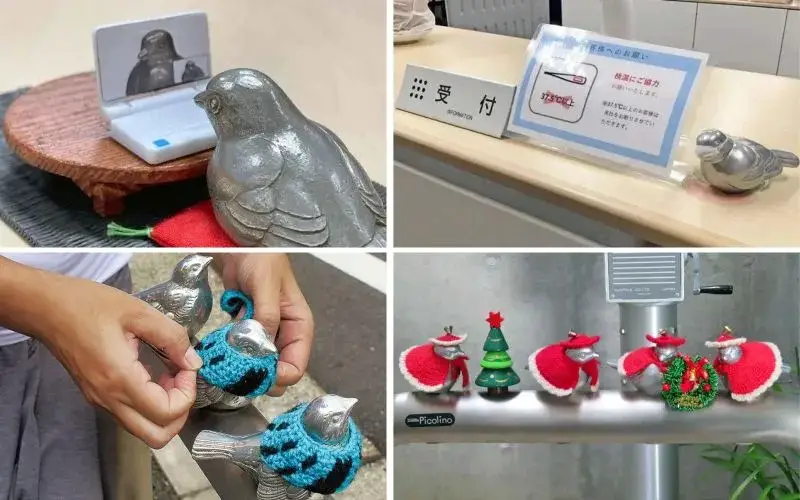
Travelers stepping into Enoshima Station often arrive with the usual expectations of train rides and timetables, but they leave with something much deeper—a sense of wonder and community. Many visitors have shared heartwarming stories of their encounters with the bronze sparrows dressed in colorful sweaters. These moments go beyond just snapping a quick photo; they become cherished memories.
- Inspiration for Creativity: Some tourists, moved by Mrs. Katsuko’s dedication, try crocheting their own miniature creations or engage in other art forms. They share their experiences on social media, often tagging Enoshima Station as their moment of inspiration.
- A Feeling of Home: Many say they felt unexpectedly at ease at the station, attributing this to the care evident in the sparrows’ outfits. It’s like receiving a warm welcome from a host who truly pays attention to small, personal details.
- Conversations Sparked: For others, these sparrows ignite meaningful discussions. From chatting with strangers about the legacy of Mrs. Katsuko to learning about the cultural importance of sparrow symbolism, the station becomes a hub of connection.
One visitor shared on a TripAdvisor review of Enoshima Island: “I never thought I’d be so moved by tiny sweaters on statues. But knowing the story behind them made me reflect on how the smallest acts can brighten someone’s day.”
These anecdotes highlight why Enoshima Station is more than just a transit hub. It’s a place where kindness is celebrated and shared, leaving a lasting impression on all who cross its path.
A Reflection of Japanese Values
Mrs. Ishikawa Katsuko’s story is more than a simple tale of one woman and her crocheted sweaters. It embodies the core values that define Japanese culture—care, connection, and meticulous attention to detail. This tradition profoundly resonates with the Japanese way of life in ways that feel both familiar and timeless.
- Omotenashi (Hospitality): Mrs. Katsuko’s act of dressing sparrows embodies omotenashi—Japan’s unique concept of hospitality. Like a gracious host, she ensured even the smallest details were perfect, creating an environment of warmth and thoughtfulness. Learn more about this Japanese mindset at Epic Adventuress.
- Appreciation for Seasons: Changing the sparrows’ outfits symbolized a respect for seasonal transitions, deeply rooted in Japanese culture. From sakura in spring to autumn leaves, every scarf or sweater reflected nature’s beauty.
- Craft and Detail: The intricacy of each crocheted piece reflects the Japanese appreciation for craftsmanship. In her own way, Mrs. Katsuko took part in the tradition of creating something both functional and beautiful, much like Japan’s celebrated kogei (artisan crafts).
- Community Bonding: Her actions turned an ordinary station into a gathering spot where strangers could connect over shared admiration. This reflects a key Japanese value of fostering harmony in public spaces.
As Moon Travel’s guide to Japanese cultural values explains, acts of care and connection are central to Japanese society. Whether it’s a tea ceremony or a sparrow’s sweater, these gestures remind us of the beauty in paying attention to the little things.
Mrs. Katsuko’s legacy does more than dress sparrows—it stitches together a message of togetherness, beauty, and thoughtfulness. Through her story, Enoshima Station becomes a mirror reflecting Japan’s love for small yet meaningful acts of kindness.
Conclusion
The story of Mrs. Ishikawa Katsuko and the sparrows at Enoshima Station is a testament to the profound impact of small gestures. Her passion for crafting tiny sweaters transformed ordinary metal sculptures into symbols of warmth, care, and community.
This legacy reminds us that acts of kindness, no matter how modest, can spread joy and inspire others to connect. Mrs. Katsuko’s thoughtful tradition at Enoshima Station continues to attract and uplift visitors, showing how one person’s creativity can touch hearts worldwide.
We are left with a simple yet powerful message: compassion and creativity can make the world a brighter place, even in winter’s coldest moments.

